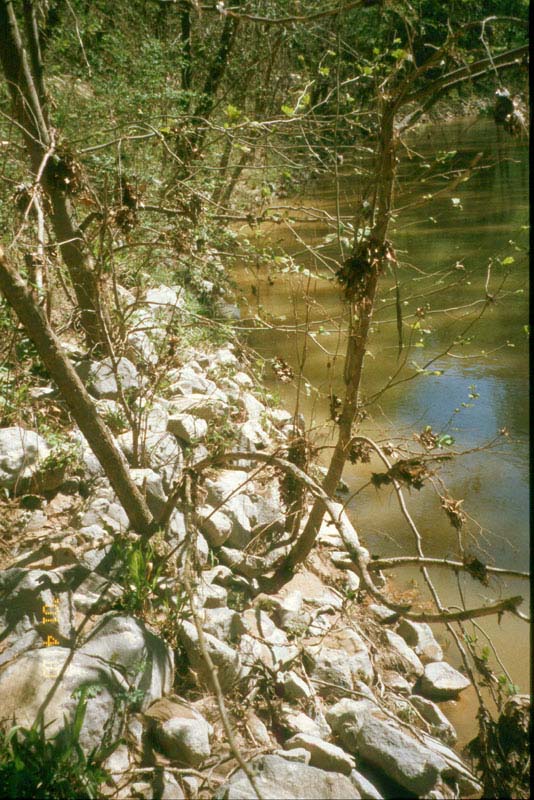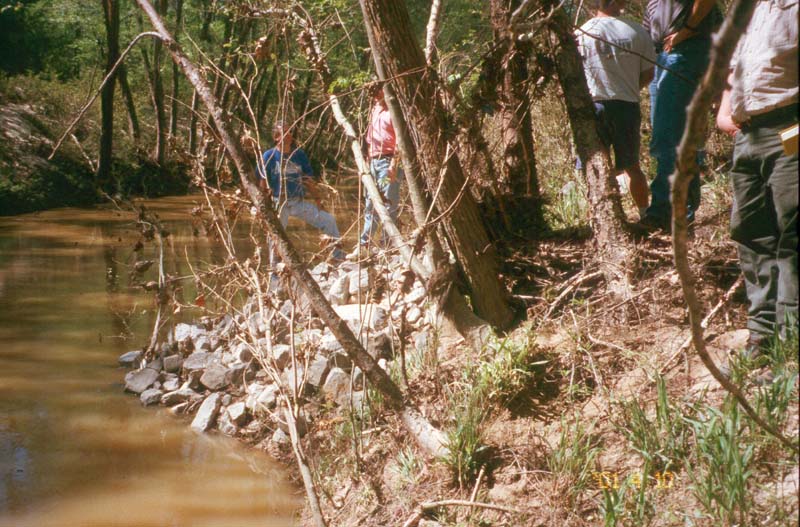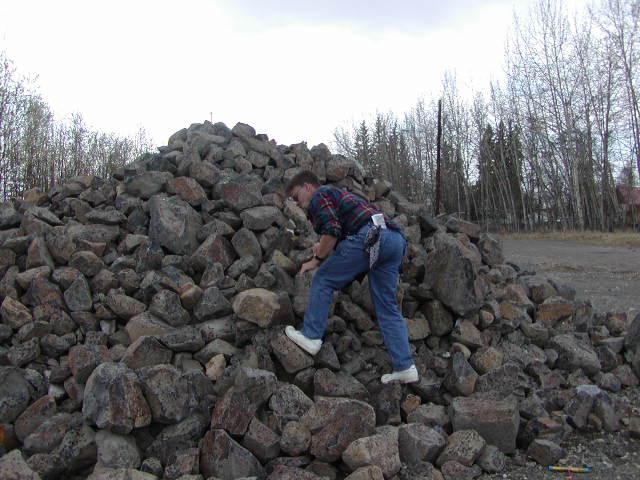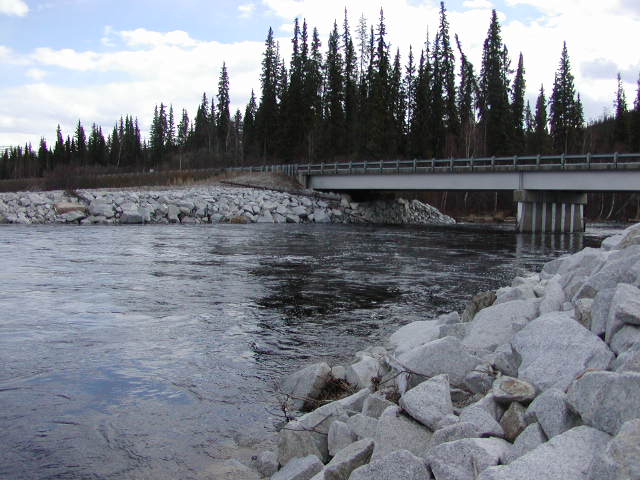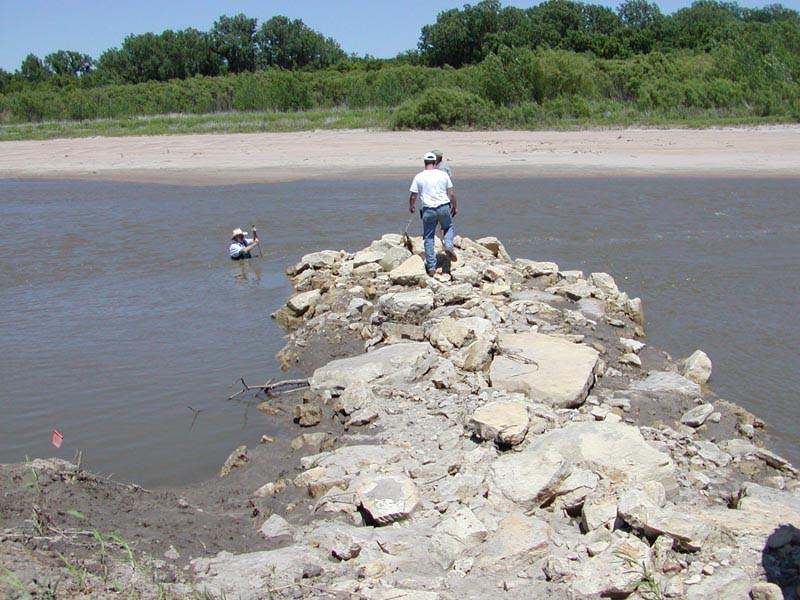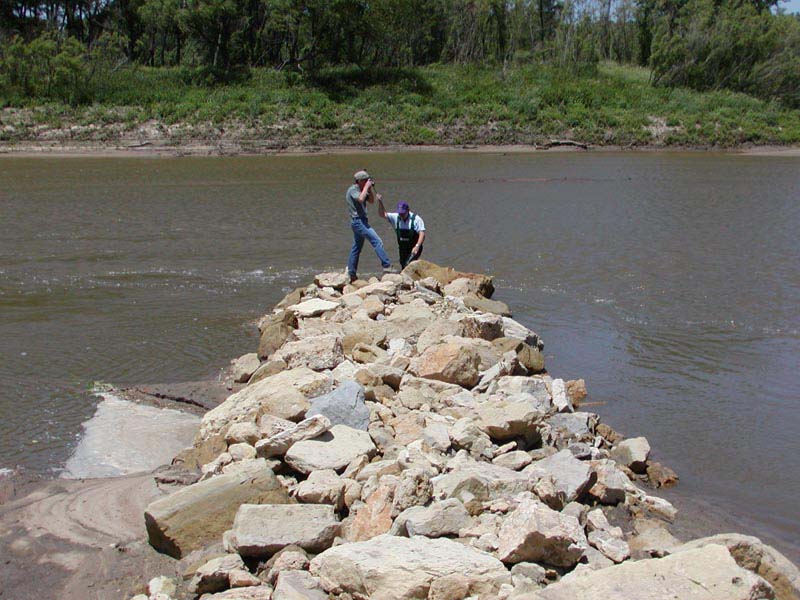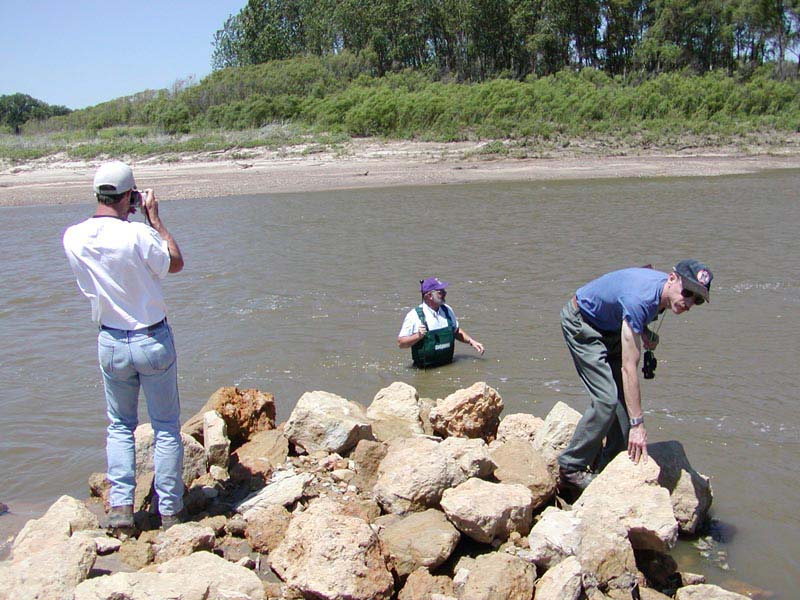| SELF-LAUNCHING
STONE / WELL GRADED STONE |
 |
For bank protection measures, well graded (poorly sorted) stone is best. Well graded (the opposite of well sorted) stone has a tendency to interlock and adjust to small deformations in the underlying bank without jeopardizing the entire structure; however, recent research investigates particulars further – see below. Poorly sorted stone also contains fine gravel-sized particles that enhance the opportunity for vegetation to become established. The fines and smaller stones fill voids between larger stones and retard interstitial water flow and subsequent erosion behind the riprap. This reduces the incidence of piping or sapping of fines and the need for filter layers and filter fabric. Thus, well graded stone with a sufficient fraction of "fine" particles are referred to as Self-filtering stone (Derrick, 2002).
Ecologists have reasoned that within certain limits, a stable structure composed of a wide range of stone sizes will provide a wider range of interstitial sizes and thus more diverse habitat than a stable structure made of more uniform stone.
Self-launching stone refers to poorly sorted stone that will fall (self-launch) into scour holes. Self-launching stone has been specified and used by the USACOE for decades in streams throughout Mississippi for such techniques as Longitudinal Stone Toes, Trench Fill Revetment, and Bendway Weirs.
One of the most common approaches for obtaining well-graded stone is to specify quarry-run or “shot rock.” Shot Rock is not sorted at all, merely loaded straight from the quarry, fines and all. Much care must be taken when purchasing this type of material to ensure that the stone does not include soil or soft shale.
|
Harland Creek, MS.
Self Launching Stone after several years. |
Harland Creek, MS.
Self Launching Stone after several years. |
Typical USACOE gradations for well graded stone are as follows:
Class A:
|
Stone Weight
k (lbs) |
Cumulative % Finer by Weight
|
|
2250 (5000)
|
100
|
|
1125 (2500)
|
70-100
|
|
225 (500)
|
40-65
|
|
45 (100)
|
20-45
|
|
2.25 (5)
|
0-15
|
|
0.5 (1)
|
0-5
|
|
Note: Assuming
stone shape midway between a sphere and a cube.
|
Class B:
|
Stone Weight
k (lbs) |
Cumulative % Finer by Weight
|
|
550 (1200)
|
100
|
|
350 (750)
|
72-100
|
|
90 (200)
|
40-65
|
|
22.5 (50)
|
20-38
|
|
4.5 (10)
|
5-22
|
|
2.25 (5)
|
0-15
|
|
0.5 (1)
|
0-5
|
Class C:
|
Stone Weight
k (lbs) |
Cumulative % Finer by Weight
|
|
175 (400)
|
100
|
|
115 (250)
|
70-100
|
|
45 (100)
|
50-80
|
|
13.5 (30)
|
32-58
|
|
2.25 (5)
|
15-34
|
|
0.5 (1)
|
0-10
|
Note: 5%
of the material can weigh more than 400 pounds. However,
no piece shall weigh more than 500 lbs. |
| David Derrick
describes the following criteria for selection of self-launching rock: 1. At the quarry or stockpile, walk up the pile of stone. If the stone falls down (self-launches) as you climb up, it meets the optimum self-launching criteria. |
|
| 2. The stone must have a ratio of the longest axis to shortest axis of less than 3.5:1. Typically, concrete rubble is not self-launching. If the concrete was 10 cm (4 in) thick (C axis = 10 cm (4 in)) then the longest axis could only be 35 cm (14”) and according to C Gradation above, 15-34% of the stone would need to be smaller and 32-58% of the stone larger. Therefore, only about 20% of well-graded, self-launching stone can be comprised of concrete rubble 10 cm (4 in) thick. |
|
Graded rock
used by Alaska DOT, Chena River, Fairbanks, AK
|
Graded stone used for
Rock Vanes in San Vacinte Creek, CA, 2001
|
|
Dear Doctor Hydro: A notable stream restoration consultant has suggested that riprap bank protection is more stable if the material is uniform-grade rather than well-graded. The argument is that at high flow velocities (shear stress), the smaller particles of the well-graded riprap may pop out and destabilize the larger ones. Since highway departments frequently use the latter specification, what does Doc Hydro think? In the past, some investigators have reasoned that well-graded riprap (a wide range of sizes in the mixture) would perform better than uniform-grade riprap (all rocks about the same size) due to the spaces between large rocks filling with smaller ones, which provides added stability. Many design manuals, including the U.S. Army Corps of Engineers manual, encourage this approach. Current thinking, however, is that the more uniform riprap provides greater stability. This conclusion is supported by several studies (Wittler and Abt, 1990; Abt et al., 1988; Maynord, 1988; Anderson et al., 1968). Wittler and Abt postulated that the greater stability of uniform riprap is due to more efficient transfer of stress than occurs in well-graded riprap. A more uniform bearing stress between similarly sized particles and the transfer of loads through the centers of the particles rather than tangentially are given as reasons for the greater stability. The study also concluded, however, that failure of uniform-grade riprap is more sudden than well-graded riprap. The referenced studies considered the effect of gradation on stability with all other factors being equal. Failure of riprap installations are often due to other factors such as insufficient toe-down depths, not keying in the leading and trailing edges of the revetment, or not providing an underlying filter. Also, the angularity of the rock is important when considering stability as this provides a greater degree of interlocking between particles, which makes the rocks harder to dislodge. Another factor to consider is the impact of gradation on filter requirements. A filter is a layer or layers of gravel, small stone, or geotextile (filter fabric) placed between the underlying soil and the rock protection. The filter layer prevents migration of fine particles through the voids in the overlying rock and permits relief of fluctuating hydrostatic pressures. Depending on the size of the riprap compared to the size of the underlying soil, a filter may sometimes be omitted. However, uniform-grade riprap with a lack of smaller particles to fill the interstitial voids is more likely to require a filter than a well-graded mixture. In addition, if a granular filter is used, the smaller sizes of the riprap gradation must properly interface with the larger sizes of the filter. Consequently, it is difficult to use large uniform riprap, and economically interface it with a granular filter. With geotextiles this is not a problem, but a granular-bedding layer is sometimes used on top of the geotextile to prevent damage from placing the riprap, especially when using large, angular rock. In summary, all other factors being equal, uniform-grade riprap is preferred over well-graded riprap. However, uniform riprap generally costs more than well-graded riprap and other design criteria often are important in the success or failure of a riprap installation. The DOC HYDRO article was provided by: Marty Teal, Hydraulic Engineer, WEST Consultants, Inc., 11848 Bernardo Plaza Court, Suite 140B, San Diego, CA 92128. References Abt, S.R., Wittler, R.J., Ruff, J.F., LaGrone, D.L., Khattak, M.S., Nelson, J.D., Hinkle, N.E., & D.W. Lee, (1988). Development of Riprap Design Criteria by Riprap Testing in Flumes: Phase II. U.S. Nuclear Regulatory Commission, NUREG/CR-4651, Washington, DC., May 113. Anderson, A.G., Paintal, A.J., & Davenport, J. T., (1968). Tentative Design Procedure for Riprap Lined Channels. Saint Anthony Falls Hydraulic Lab., Project Report. No.96, University of Minnesota, Minneapolis, MN. Maynord, S.T. (1988). Stable Riprap Size for Open Channel Flows. Technical Report U.S. Army Corps of Engineers, HL-88-4, Waterways Experiment. Station, Vicksburg, MS. Wittler, R.J. & Abt, S.R. (1990). The Influence of Uniformity on Riprap Stability. Hydraulic Engineering, Vol. 1, Proceedings of the 1990 ASCE National Conference, San Diego, CA, July 30 - August 3, pp. 251-265. |
REFERENCES
Derrick, D. (2001). Advanced Streambank Protection Course Material. US Army Corps of Engineers, Vicksburg, MS.

